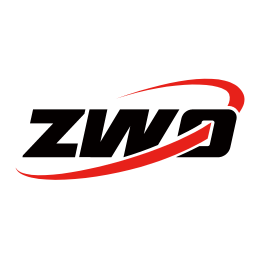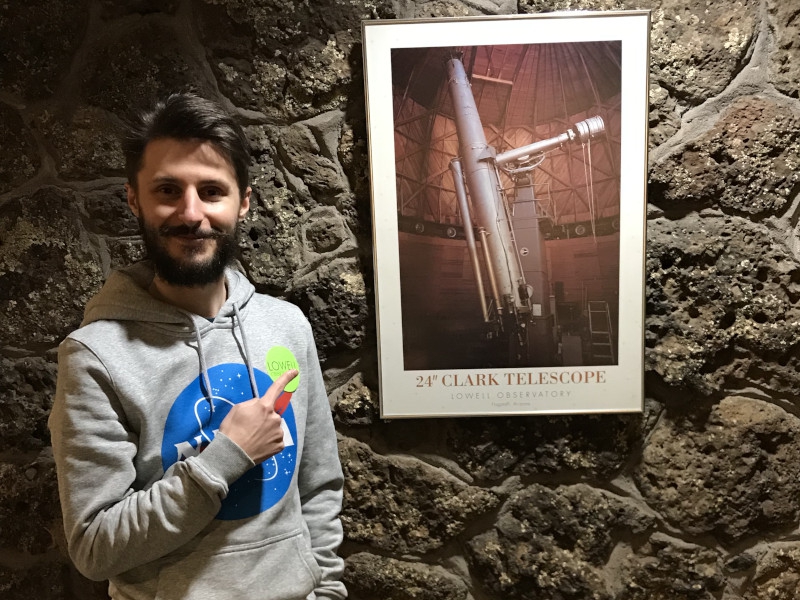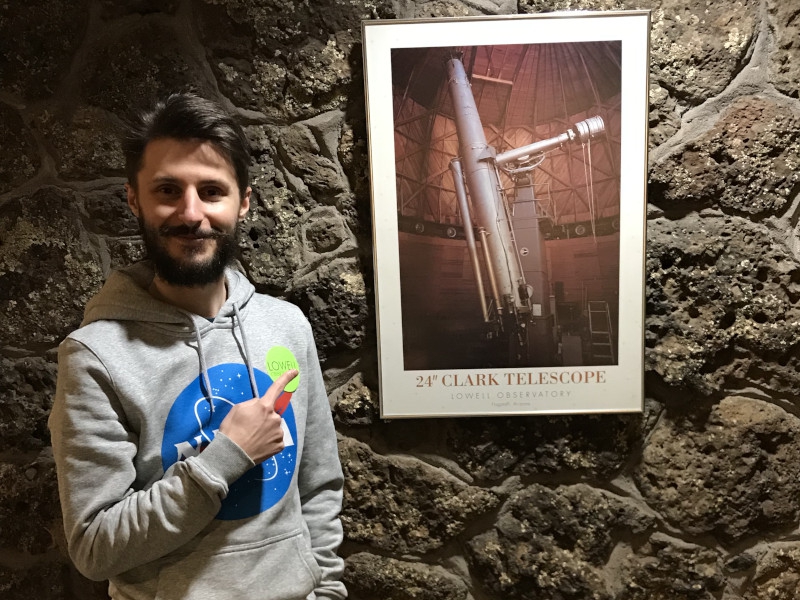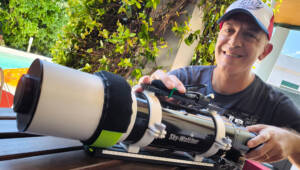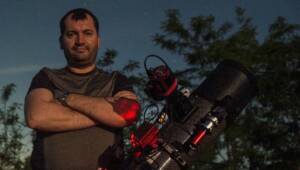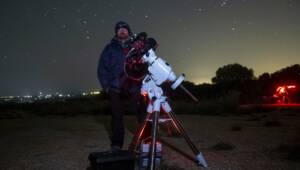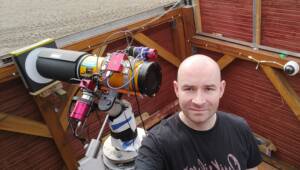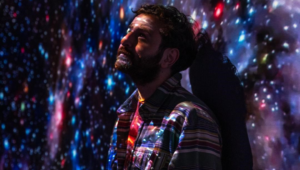Victor Van Puyenbroeck is the winner of ZWO 2019 ASIWEEK #31 and has brought us many extraordinary astronomy photos. To make our ZWOers know this excellent astrophotographer better, we make this interview. Let’s all take a look now.
Q1: Hi,Victor. Congratulations! Your work won the ASIWEEK Astrophotography Competition #31. Could you introduce yourself to everyone?
Hi, my name is Victor Van Puyenbroeck and I’m a 30-year-old imager from Belgium. I like to photograph deep sky and I’m fascinated by the science and beauty that lies within these distant objects.
Victor Van Puyenbroeck visiting Lowell’s observatory in Arizona, USA
IC 1805 HaOIII, TS80APO+ASI1600MM, 2.3 hours, Bortle 7
Q2: When did you start like astronomy? And when did you have your first telescope? What’s the feeling in first observing?
I was fascinated by astronomy and astrophysics during my teens and loved to read about the history of the universe, star formation and black holes. Unfortunately, I did not look up at the sky very much.
This changed in January 2016 due to a rare alignment of the planets Mercury, Venus, Mars, Jupiter and Saturn. Seeing those bright and colorful ‘stars’ in a line triggered a desire to capture this celestial event in a photograph.
My first telescope was a classic Sky-watcher ST80 achromatic doublet refractor, which I still use today. It’s very easy to setup for visual observing on an alt-az mount, and a great way to show the Moon, planets or bright deepsky objects like M42, M13 or M31 to family and friends.
I can still remember the nights I saw the Galilean moons of Jupiter and the rings of Saturn for the first time. The telescope felt like a window to another world, invisible to the naked eye, and I wondered what the first astronomers must have felt.
Moon with Earthshine, TS80APO+3X TeleVue barlow, ASI120MM, ZWO RGB filters
Q3: We know astrophotography need a lot of practice, it’s really hard to handle it, maybe need years to improve skills. When did you start to do astrophotography? And what equipments did you use?
I started out in 2016, taking pictures from my apartment’s balcony in the middle of the city and from the parks around my home. Equipment-wise, my first photographs were taken with a simple shutter release cable, Canon 450D DLSR and lenses from my photography hobby. Locating objects in the night sky without a go-to mount was quite difficult in the beginning, so I practiced on wide-field constellation shots or bright targets like the Orion Nebula or M31.
After a few weeks, I was totally hooked on astronomy and decided to spend more money on my first tracking mount, a Sky-watcher EQ5 Pro. This mount was the centerpiece of my mobile setup and has served me well on trips to darker suburban sites around my apartment. I only upgraded to an EQ6-R in June 2019, after I moved to a new house with a backyard in Bortle 7 skies.
One of the things that I love to do is looking back at my previous results to see how my skills, equipment and style improves and evolves over the years. I constantly try to learn new things and improve my processing to steer the results towards my artistic desires.
Retrospective: TS80APO+ASI1600MM vs ST80+450D
Q4: When did you know about ZWO? And what’s the first ASI camera you have?
My first camera from ZWO was the ASI120MM. Articles from Astronomy Now, Sky at night magazine and Sky & Telescope were praising the performance of this camera and it was priced very competitively. I was looking for a good guide camera and the ASI120 was much more sensitive than the Orion StarShoot guide camera that many other astrophotographers were using at the time. I decided to buy the mono version for maximum guide performance.
I have used the ASI120MM camera for almost 3 years now and it has performed very well, both for autoguiding and for taking pictures of the Moon and planets. For high-resolution work with my f/6 refractor, I added a ZWO RGB filter set and a 3X Barlow to the imaging train.
Galaxies from Bortle 7 skies, TS80APO+ASI1600MM, Ha-LRGB or LRGB, 43 hours total exposure
Q5: Which ASI camera is your favorite? And why are you choose it?
Definitely the ASI1600MM-C. Photographing objects from the city turned out to be way harder than I thought, at least with the gear that I had in the beginning. At one point I was actually considering giving up the hobby because of light pollution and bad weather.
This changed completely after I bought the ASI1600MM-C, because it allowed me to do narrowband imaging, which is ideal for someone who lives in the middle of heavy light pollution. It was a new generation of mono CMOS cameras with low read noise. This makes it much easier to take sky-limited sub-exposures through narrowband filters when paired with a fast telescope. It was also a much more affordable camera than the CCD alternatives at the time, so I probably wouldn’t have gotten where I am today without ZWO.
NGC 7380 in narrowband bi-color (Ha + OIII), TS80APO+ASI1600MM, 4.8 hours, Bortle 7.
The 16 megapixel sensor in the ASI1600MM-C camera offers a lot of versatility behind a small 80 mm apo. You can either use the full frame to capture wide-field views or large emission nebula, or crop to show fine detail in galaxies and smaller nebula. My setup is slightly under-sampled and drizzle stacking images from a mono sensor often allow me to reveal additional detail in close-ups.
M27 HaOIII + RGB stars, 2x Drizzle, TS80APO+ASI1600MM, 5.4 hours, Bortle 9
Q6: What setup do you use currently? Could share a picture of your setup?
When I started out, I designed my setup to be mobile so I could drive my gear to darker areas. The robustness of a refractor is really convenient for a mobile setup, but I would love to have a Newtonian one day for high-resolution DSO work.
My current setup consists of a TS 80mm f/6 apo reduced to 379mm focal length, an ASI1600MM-C V3 camera and a ZWO EFW filterwheel with full ZWO filter sets (31 mm LRGB and HaOIIISII) on a Sky-watcher EQ6-R mount. For guiding, I use an ASI120MM and APM 50/205 mm guidescope.
Current deepsky equipment setup in the backyard
Q7: What’s your impression of ZWO?
For me, ZWO is a pioneering company that embraced CMOS cameras in a world dominated by CCD technology. ZWO offers many different products that work well together and their software is very stable.
I believe that the quality and price point of their products has made two big changes in the astrophotography landscape: First, the hobby has become much more accessible. On the other hand, expert imagers have shown that ZWO cameras can produce excellent results on professional equipment, rivaling CCDs.
